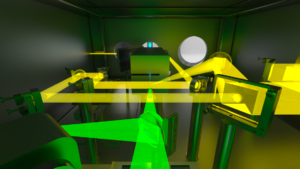An intense laser pulse propagating in an under-dense plasma can drive a relativistic plasma wave in which electrons can be injected and accelerated to relativistic energies. To date, the most efficient mechanism to accelerate electrons in a plasma wave is called the bubble, blow-out or cavitated wakefield regime. This regime is reached if the waist w0 of the focused laser pulse is close to the plasma wavelength, the pulse duration is approximately equal to half a plasma wavelength, and the laser intensity is sufficiently high (normalized vector potential a0> 2) to expel most of the electrons out of the focal spot. When these conditions are met, an ion cavity is formed in the wake of the laser pulse. Electrons can be trapped at the back of the cavity and accelerated by the high electric field with an accelerating force of the order of 100 GeV/m. These accelerated electrons oscillate across the cavity axis at a period called the betatron period and emit a synchrotron-like X-ray radiation, called betatron radiation, in the direction of the electron velocity. The pulse duration of this X-ray source is femtosecond, the source size is of the order of a micrometer or less and the peak brightness is of the order of 1022 ph/0.1% BW/s/mm2/mrad2.
Compton source operates by colliding a relativistic electron bunch and an intense laser pulse. For an entirely optical realization of this scheme, two intense laser pulses are required, the first to create a plasma accelerator and the second to scatter off the accelerated relativistic electrons. The scheme provides a double Doppler upshift of incident photon energy by relativistic electrons. We expect high-energy femtosecond X-ray radiation from Compton backscattering (up to few hundreds of keV range) in a purely optical scheme that is both simple and robust.
The beam lines rely on focusing the L3 and/or L3 AUX laser into a gas jet or a gas cell. For an appropriate choice of experimental parameters (laser intensity, laser spot size and duration, and electron density in the gas), electrons are accelerated to relativistic energies by plasma wakefield acceleration and wiggled by the plasma itself (Betatron source) or by a second laser pulse (Compton source). This results in the emission of intense femtosecond X-ray or gamma-ray beams emitted from a micron-size source. The features of the radiation produced will depend on the needs of the end user. It will be possible to deliver either narrow spectrum (10% energy spread) or broadband radiation in a spectral range from keV to a few MeVs.
Optical configurations
Two configurations are considered. The focal length of the focusing optics is chosen to reach a sufficient a0 parameter (a0 = 4–5) and to match the conditions for efficient laser wakefield acceleration in the bubble regime.
For the production of Betatron radiation, only one laser pulse (L3) will be used. The laser is focused using a spherical mirror with a 3–5-meter focal length onto a gas jet or a gas cell. The choice of the focal length is defined to reach a laser strength parameter of a0 = 4 considering a 30 J/30 fs laser pulse. The electron density of the plasma will be in the order of 1018 cm–3 . Deciding to choose a gas jet or a gas cell will depend on the experiment. Gas cells allow for larger propagation distances to be reached and have tunable lengths. Gas jets are simple to implement and are supersonic with sharp density gradients. The gas length determines the length of acceleration and therefore the electron energy and the energy and flux of the radiation.

Figure 1. Schematic description of Betatron and Compton radiation in the Experimental hall E2. The first laser beam (green) is used to accelerate electrons and the second beam (yellow) is focused onto the accelerated electron beam, collide with them and emit Compton radiation (blue) in the direction of the electron beam.
L3 and L3 AUX laser pulses will be used for the Compton source. The first is used to accelerate electrons. The second laser beam is focused onto the electron beam. The radiation is produced at the collision of the laser and the electrons and is emitted in the direction of the electron beam. A third low energy laser pulse will be used in some cases to trigger the electron injection in the laser plasma accelerator. This will be used to inject electrons locally into the wakefield to produce nearly mono-energetic electrons with tunable energy. The energy will be adjusted by varying the collision position within the gas target. The Compton source requires the temporal overlap of L3 and L3 AUX beams in the femtosecond range.
Performance requirements
The following table summarizes performance requirements, which depend on the energies of incoming lasers L3 and L3 AUX (for staging the output power, see more in the section on lasers ). In Phase A, the L3 (Stage 1) laser will be used for the Betatron beam line. To produce appropriate energy in gas, the “short” focusing off-axis parabola (f = 2 m) will be used. In Phase B, with full power of L3 laser and a ‘long’ focusing off-axis parabola (f upto 5 m) will be implemented.
|
Source |
Betatron Phase A |
Betatron Phase B |
Compton |
|---|---|---|---|
| Energy range |
1–10 keV |
1–100 keV |
100 keV–5 MeV |
| Photon number |
108 |
108 |
108 |
| Spectrum |
Broadband |
Broadband |
Broadband/Monochromatic |
| Pulse duration @ source |
10 fs |
10 fs |
10 fs |
| Divergence |
40 mrad |
20 mrad |
20 mrad |
| Source size |
< 5 microns |
< 5 microns |
< 5 microns |





